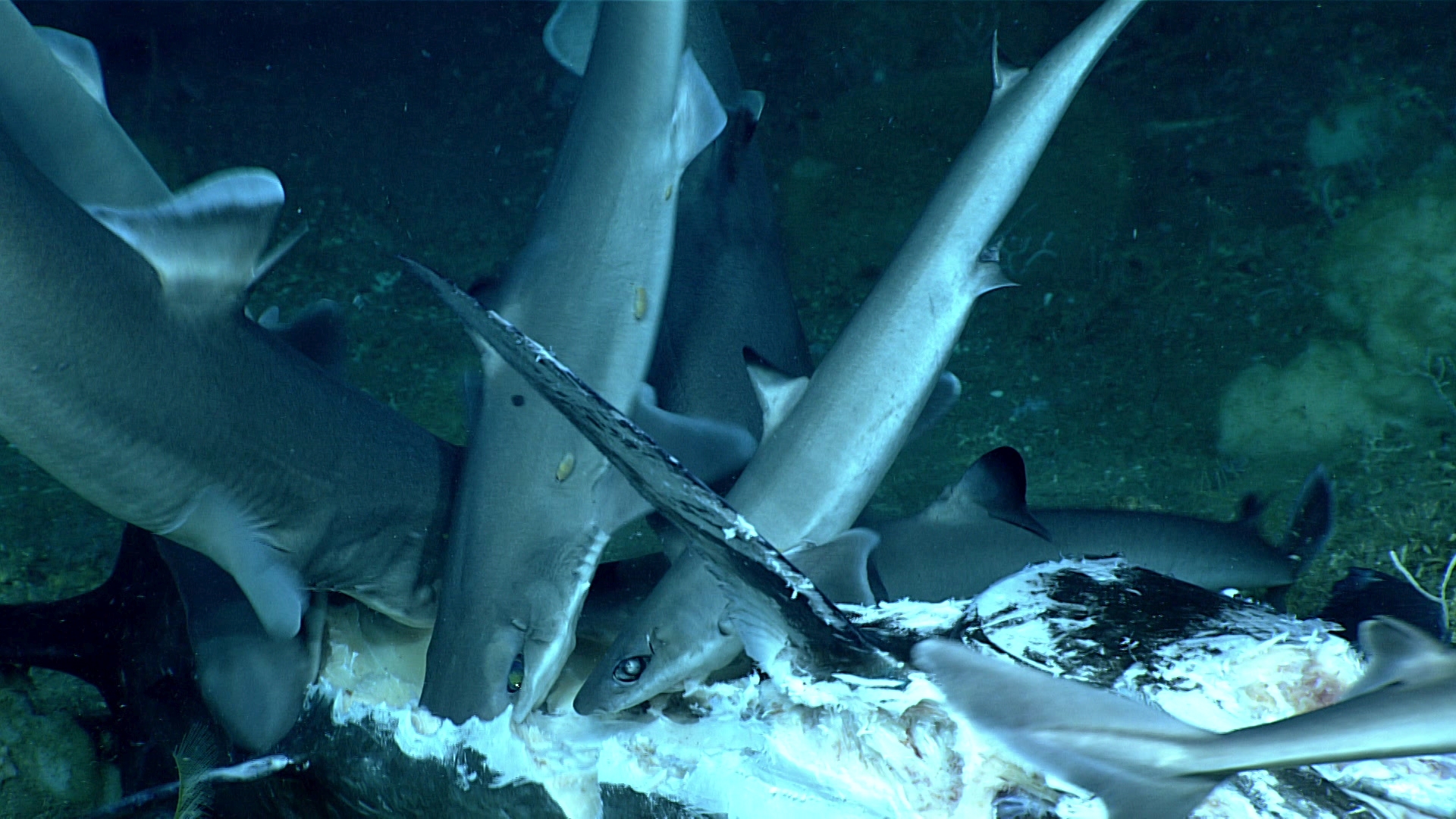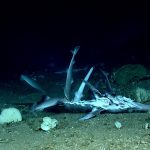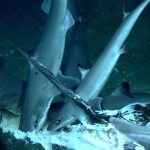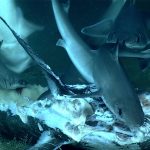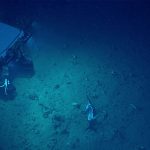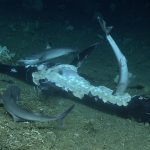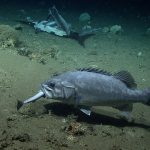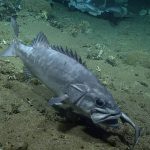While seasonal holidays and associated feasts may occupy our thoughts in the coming weeks, a team of researchers including Peter Auster, UConn Marine Science Research Professor Emeritus and Senior Research Scientist at Mystic Aquarium, got a chance to be distant guest at a more primal feast rarely observed.
Last year, using a remotely operated submersible vehicle (ROV), the team stumbled upon a feeding frenzy of deep sea sharks at a depth of over 450m (1500 feet) beneath the ocean’s surface. Their findings have recently been published in The Journal of the Ocean Science Foundation. The feast featured a main dish of swordfish, and the attendees included two species of deep sea sharks, crabs, eels, and other ravenous deep-sea creatures. The encounter was not only exciting to see, but it helped provide insights into a vital and widespread topic of discussion regarding climate change – carbon sequestration.
Auster explains that, prior to global scale fisheries, large animals nearer the surface would die from predation or old age, and then sink into the abyss, taking the carbon they had accumulated through life with them. But rather than simply be buried in accumulating sediments, the carcasses serve as an important food source, entering a deep-sea food web. However, due to historic overfishing of larger sea life such as whales, and continued exploitation of tuna, swordfish, and sharks, Auster says these “food fall” events are fewer and farther between.
“If we didn’t exploit swordfish and tuna, and if we weren’t still living with the remnants of the 19th century whaling industry, these food falls would happen more frequently,” he says. “The food web linkages and populations of these deep-sea species may have looked very different than they do today. Most work in terms of food fall studies has either come from serendipitous encounters with dead whales and other species on the sea floor or experiments where a whale washed up on a beach and was sunk to see how communities feed on the whale and the succession of species that live on the whale and their oil rich bones.”
Other experiments have used fish and a recent novel experiment using alligators that used to be more common in tropical and subtropical regions.
As a result, much remains to be learned about the communities of animals that use food falls as a prey subsidy, with lots to eat and no search time once the fall has been encountered. For instance, how does this phenomenon vary across depths? How do predators search for and find the food? How many of each species are present, and how do they interact over the time span a food fall is present? Each study serves as an important opportunity to fill those knowledge gaps, so both animals and researchers alike are thrilled at the discovery of a food fall.
“It’s like a Thanksgiving meal for sharks. We have no good idea how often they find a carcass to gorge on a huge meal,” Auster says. “The sharks individually eat many smaller organisms without that feeding frenzy kind of event occurring.”
Among the animals the researchers glimpsed chowing down include two different species of sharks called the Roughskin and Genie’s dogfish, crabs, cutthroat eels, and Wreckfish. The authors note that the feeding frenzy was catching the attention of predators and scavengers from a distance, likely due to both acoustic and odor cues to signal the find. Wreckfish joined the gathering even though they are not built to feed on the swordfish carcass. In a surprising move, one Wreckfish ambushed and swallowed – whole – a small shark. This is a new insight, as previous studies showed remains from a variety of sharks in the stomachs of Wreckfish and it was hypothesized that the larger remains occurred when they fed on fishing discards.
The Deep’s Food Web and Carbon Capture
Food webs are complex, and unlike those on land, our understanding of deep sea food webs remains incomplete largely due to logistical difficulties of working at such great depths. Vast quantities of carbon can be transported and sequestered into deep-sea food webs. The carbon, whether animal or plant material, falls like a rain into deeper waters, where it enters the food web, says Auster. This debris can either cycle within the deeper community of animals and microbes, or it can become incorporated into sediments. The topic of carbon sequestration is an important one, as human-caused climate change and excess amounts of carbon in the atmosphere are leading to rapid global warming.
While humans overfish the oceans and therefore remove carbon from the oceans, we are also disrupting deep-sea food webs and the carbon sequestering and storage services they provide.
Auster notes a concept called “Blue Carbon” a process by which carbon is captured by the world’s oceans. A recent article by other authors points out that, when land plants and animals die or become part of terrestrial food webs, a significant part of their carbon is released to the atmosphere. Large fish in the ocean, prior to industrial scale fishing, would sink, and their carbon would enter deep-sea food webs and sediments. With the scale of fishing that has taken place over the last century, a great deal of blue carbon has been transported to land for human consumption and related uses such as animal feed. “I’m not against fishing, we just need to understand what we are doing,” says Auster. “For example, what are the tradeoffs if we leave some of these populations to expand and recover, filling their ecosystem roles? This is something we need to resolve at an international level.”
As policymakers and researchers look to ways to sequester atmospheric carbon, fisheries management that takes this issue into account could be an important element. Studies like this one give deeper insight into the details of the food webs involved.
“It is an important process we don’t fully understand in terms of how carbon from large animals inhabiting surface waters makes its way to the deep ocean,” says Auster. “We know enough broadly to evaluate what our impacts are and how they function, but we don’t know as much as we do about forest or coastal food webs. We don’t know everything but we know enough to take the uncertainty into account and not delay actions.”
Auster reflects on the serendipity of this finding and jokes that his gills have been drying out since the pandemic has meant a halt to research trips. This paper illustrates the importance of getting out as much as possible, when possible: “You don’t normally get to see these things. To come across that on an ROV dive when we were searching for something completely different, it goes to show the more time you spend under water, the more rare events you get to see and understand.”
